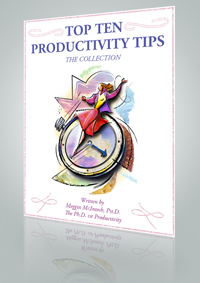Read a Book in an Hour by Meggin McIntosh, Ph.D.
 As an educator, you have to read a great deal in order to keep up professionally AND as an educator, you probably love reading for pleasure, too. There are times for slow, no-rush, no-worries reading. However, there are other times that we are reading as if we had all the time in the world because we don’t know how to read quickly.
As an educator, you have to read a great deal in order to keep up professionally AND as an educator, you probably love reading for pleasure, too. There are times for slow, no-rush, no-worries reading. However, there are other times that we are reading as if we had all the time in the world because we don’t know how to read quickly.
This week’s tips aren’t going to teach you to read 2000 words per minute. (Although I *can* teach you that in a workshop. Contact me for me information on that). What these keys *will* help you do is to read and retain only those portions of a book that suit your needs and they are particularly suited to informational/non-fiction books rather than fiction.
- First, ask (and answer) ‘What is my purpose for reading?’
- Write down your purpose on a bookmark. An index card works great for this.
- Make sure the book is “broken in,” i.e., that you gently open the book at the center and press it, open at the ¼ and ¾ portions and press it, etc. Your books will last longer and be easier to use if you do this when you get the book. People new to my workshops laugh and think I’m kidding when I hand out books and then make sure that they “open their new books properly.” My regular participants starting doing so without my asking–and are very proud of themselves, may I say!
- Read the introduction, if there is one. This helps you get a general sense of the book.
- Survey the table of contents, noticing what is of interest to you, given the purpose you have noted on your bookmark.
- Revise your purpose, as needed. Sometimes what we thought we were going to read about isn’t what the book is about–and so we need to reframe our purpose.
- Set a timer for one hour, go to an appropriately quiet reading spot and read *only* what you perceive to be the most valuable. Note: By the time you get to setting a timer, you may have already decided that this book isn’t for you, after all.
- Whichever parts you are reading, read fast! Just speed up your eyes! Your brain is perfectly capable of staying with you, I promise.
- Read with a pencil or pen in your hand. Post-it® notes are useful as well.
- Jot down key words or mind map as you go. When you finish, take a look at your notes and/or mind map. Add additional thoughts, words, ideas, or sentences to what you have already written. Think about what you have learned and how you will apply this information.
Joe Vaughn, one of my mentors in graduate school (I have a Ph.D. in Reading Education & Linguistics) said, “Reading is an event of thinking cued by text.” Let this definition serve you. Let the text cue your thinking about the topic. Imagine reading 5 – 10 or more books a week. You can.
Oh, and one more note, you could teach this to your students, particularly if you teach grades 6 – 12 or at the college level.
 If you liked these tips and would like over 560 practical, immediately-implementable tips to read, print, and/or post as reminders, then you will want the Top Ten Productivity Tips – The Collection, available to access and download right away! Inside this full-color, 108-page productivity manual, you’ll find several hundred tips covering topics such as meetings, workspace organization, planning your day, effective delegation, and how to keep your mind focused on your work. With these clever tips in hand, you’ll be more peacefully and predictably productive than you’ve ever been.
If you liked these tips and would like over 560 practical, immediately-implementable tips to read, print, and/or post as reminders, then you will want the Top Ten Productivity Tips – The Collection, available to access and download right away! Inside this full-color, 108-page productivity manual, you’ll find several hundred tips covering topics such as meetings, workspace organization, planning your day, effective delegation, and how to keep your mind focused on your work. With these clever tips in hand, you’ll be more peacefully and predictably productive than you’ve ever been.


